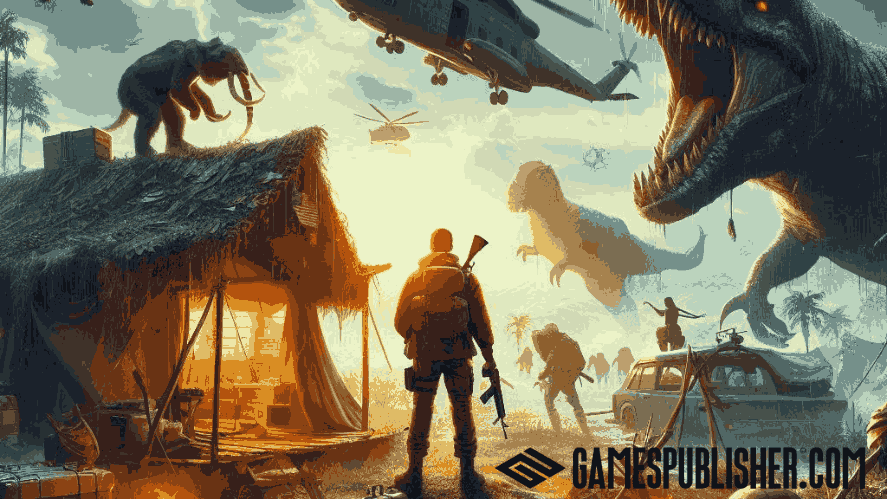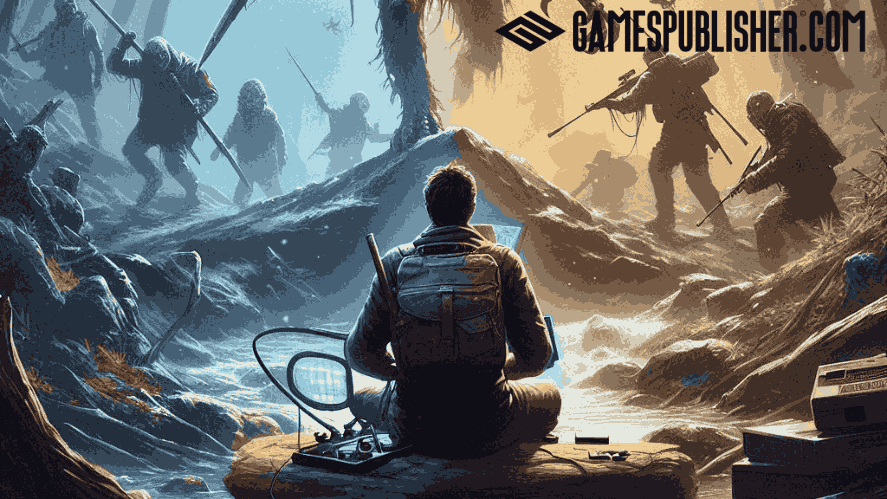Gamespublisher.com is an ideal place where we aim to provide valuable resources for both game developers and enthusiasts.
Whether you’re an aspiring developer or a seasoned video game publisher, you can gain insights here into game origins, game mechanics, and player preferences, which help to shape better games and publishing strategies.
For game developers, understanding a genre’s origins and evolution yields invaluable knowledge.
Survival games, in particular, have evolved into a dynamic genre, capturing the attention of players worldwide. The survival game genre has grown from niche beginnings into a staple of modern gaming.
In this article, we will explore the history of survival games, from the early examples to the wide range of themes and gameplay features in today’s games.
Defining Survival Games
Survival games are all about putting players in challenging situations where they must manage resources and face different threats.
In these games, survival is the primary goal, and players must use their skills to stay alive.

What Makes a Survival Game?
At their core, survival games are about just that – surviving.
More specifically, they test a player’s ability to stay alive and even thrive in the face of scarcity, environmental threats, and other hostile forces.
Survival games drop players into a harsh world and force them to scratch and claw for every resource. Players need to find things like food, water, and materials to make tools to stay alive in these challenging situations.
Games like Rust, The Forest, and Don’t Starve show how modern survival games challenge players while keeping them engaged.
In Rust, you’re dropped into a dangerous multiplayer world where you have to scavenge resources, build a secure base, and defend yourself not just from wildlife and the elements but from attacks by other players as well.
The Forest goes in a different direction, focusing more on story and exploration. Players survive a plane crash and end up in a mysterious forest. So, along with finding food and building shelter, you’re slowly uncovering the secrets of what happened in this strange place.
And then there’s the hand-drawn survival world of Don’t Starve, where you gather supplies and craft tools during the day but have to be cautious of shadows and dangerous beasts that come out at night.
Core Survival Game Mechanics
Survival games are built around a few core gameplay mechanics that create challenging and engaging experiences for players. These include:
1. Scarcity of Resources
An essential part of survival games is that you start with very few supplies. Food, water, weapons, and other things you need to stay alive are limited.
As you explore, you have to find more resources. But you can never find enough of what you need. This makes managing the items and supplies you find very important.
2. Crafting Systems
Most survival games let you build valuable items from things you find. For example, you may be able to make an axe if you find some wood and rocks to tie together.
Building better and better tools gives you goals to work towards. It also allows you to create items you really need to keep surviving.
3. Open-world Environments
The survival video game industry takes place in open worlds like forests, oceans, or abandoned cities, not linear levels. You can explore anywhere in the world freely, finding essential resources as you go.
But openness also means danger can come from anywhere, so you must be careful as you explore.
4. Player Survival
The main goal in survival games is to stay alive by keeping your hunger, health, and other needs met. You have to find food and water to avoid starving.
You have to bandage injuries so you don’t bleed out. Keeping your needs met is a constant challenge you have to overcome.
The Early Roots of Survival Games
Survival gameplay traces its back to some of the very earliest video games.
While the genre wouldn’t fully form for decades, pioneering titles planted the seeds that later bloomed into survival gaming staples.

Proto-survival Games
The earliest glimpses of survival mechanics came through games focused on strategic resource management and decision-making.
One of the first survival games in the gaming industry to put players in a survival situation was Oregon Trail, initially released in 1971.
In Oregon Trail, you took on the role of a pioneer leading a wagon train across the perilous trail out West.
You had to carefully manage limited supplies like food, ammunition, and medicine while also making tough decisions about handling random events like illness, injuries, and broken wagon wheels.
Another early influence was the dungeon crawler Rogue from 1980.
Rogue introduced the concept of permadeath to gaming, meaning that if your character died in the dungeon, it was game over for good, and you’d have to start from scratch.
While exploring each procedurally generated level, you still had to watch your supplies.
Rogue wasn’t a full survival game, but the threat of permanent failure and emphasis on careful resource management set the stage for crucial survival mechanics.
Influences from Other Genres
As the genre developed in the video game industry, it also took inspiration from adventure games, RPGs, and strategy titles.
These influences added richer storytelling, character progression, and resource planning elements to the survival experience.
The result was an emergent genre centered on enduring adversity, adapting to challenges, and managing scarce supplies to achieve long-term goals.
While modern survival games have more complexity, these early experiments established the core appeal of outlasting whatever the game development throws at you.
The Emergence of Survival Games as a Genre
Survival games started becoming their own genre in the early 1990s. In the meantime, two games were influential in shaping this genre.
In 1992, UnReal World was one of the first wilderness survival games. Set in tough Iron Age Finland, you had to forage, hunt, build shelter, and more to survive. This set the standard for later wilderness games.
Then in 1993, Wolf was a sci-fi survival game development as it was set in a space colony with monsters. You had to fight enemies and manage supplies to escape. This showed that the best survival games didn’t have to just be in nature.

Over the following years, more games used survival mechanics. The Elder Scrolls series added elements like food and disease. The title S.T.A.L.K.E.R. also mixed survival with shooter gameplay.
In 2009, Minecraft exploded in popularity. With its blocky, open world, you had to scavenge, craft, manage hunger, and defend against monsters. Its fun survival mode brought the genre mainstream and gained popularity.
The modding communities also played a big role. Minecraft mods expanded features like food cultivation and technology trees.
Meanwhile, player-created mods for military sims like Operation Flashpoint and ARMA introduced survival mechanics like disease and hardcore resource monitoring.
So, in the 1990s, a few innovative games started the survival genre, and by the 2000s, Minecraft helped turn it into a mainstream hit, moving it from a small niche to a popular trend.
DayZ and the Modern Survival Game Explosion
If Minecraft made survival gaming mainstream, then DayZ cemented its popularity as a top genre.
Originally a mod for the military sim ARMA 2 in 2012, DayZ soon launched as its own game and sold over 3 million copies during the early access phase. Its incredible success kicked off a new wave of the best survival games.
DayZ kept ARMA 2’s realistic simulation gameplay but transformed it into a much more immersive and challenging survival experience.
Set in a zombie apocalypse, you scavenged for weapons and supplies, maintained your health, built fortifications, and fought off undead.
Importantly, you must also watch your back against other players in the open world survival games. DayZ really captured the tense feeling of both fighting the environment and fellow survivors.
Gamers loved how DayZ combined these survival elements in a fresh way.
After it took off, survival games exploded on PC and consoles.
Some copied Dayz’s zombie setting, like 7 Days to Die (2013), while others blended survival with crafting, like Rust (2013) and ARK (2015). Unique titles like Don’t Starve also emerged. But they all focused on that core survival loop.
By the mid-2010s, good survival games had become a firmly established genre, expanding to consoles and mobile.
What had once been a small niche was now one of gaming’s most popular styles. DayZ’s phenomenal success cemented survival gaming’s place in the mainstream.
Themes and Innovations in Modern Survival Games
While retaining those definitive survival mechanics, games have introduced a sweeping range of themes and innovations that continue pushing the genre forward.
Creative thematic twists on survival have emerged as a significant trend. Traditional post-apocalyptic, wilderness, and sci-fi settings have been joined by imaginative environments like:
- Alien planets (Astroneer, Osiris: New Dawn)
- Oceanic exploration (Subnautica, Stranded Deep)
- Prehistoric lands (ARK: Survival Evolved, Horizon Zero Dawn)
- Supernatural horror worlds (The Forest, Green Hell)
- Frozen wastelands (The Long Dark, Frostpunk)
On the gameplay front, survival continues to get more complex. Games now track details like variable caloric intake and body vitals monitoring.

Crafting offers hundreds, if not thousands, of combos and schematics to discover. Sophisticated base building lets players construct elaborate compounds and settlements.
Harsh environments have moved towards realistically simulated ecosystems and dynamic weather.
Multiplayer integration has also grown into a prominent feature of recent survival games. Shared world experiences with friends can amplify the highs and lows inherent to survival gameplay.
But open PvP servers also inject wariness about other players. Titles like Rust and Ark: Survival Evolved have leaned into emergent player-driven storytelling.
Meanwhile, storytelling has also become more common in survival games. Games like The Forest and Green Hell include storylines to discover, while Subnautica and The Long Dark reveal story elements through exploration.
Now, survival games blend mystery, adventure, and horror, adding more layers to the survival experience.
Survival Games’ Influence on Other Genres
Survival mechanics were once the domain of a niche category. But they have steadily bled into all corners of the gaming landscape, becoming entangled with other major genres.
Survival games have mainly influenced horror games, especially during the survival boom of the 2010s.
Mainstream horror series like Resident Evil, The Evil Within, and Dead Space incorporated limited resources and more evasive combat, which made them even scarier.
On the indie side, games like Darkwood and Sylvio emphasized resource management alongside horror elements to add tension.

Elements of survival problem-solving have also appeared in adventure games like fire propagation in The Legend of Zelda: Breath of the Wild. Turn-based tactics games now use permadeath and procedural elements similar to survival roguelikes.
Even blockbuster open-world RPGs like Fallout: New Vegas have integrated survival modes that add needs like hunger, thirst, and sleep to enhance realism.
Survival mechanics have also impacted multiplayer genres in exciting ways. The rise of evolution-based games like Rust influenced social dynamics in games like Among Us.
And most notably, the hugely influential battle royale genre descended directly from survival gaming DNA.
Titles like PlayerUnknown’s Battlegrounds and Fortnite adapted the search for weapons and gear, ever-shrinking safe zones, and player elimination of early “Hunger Games” mods for Minecraft and ARMA 2.
The Future of Survival Games
Today, survival games sit among gaming’s most popular genres. They’ve come a long way from their humble beginnings. So where might this genre go next?
Many new survival games today are heading toward more realistic and detailed survival simulations. Games like SCUM (2018) model complex needs like nutrition and vitamins.
The Long Dark (2017) realistically simulates cold weather survival. Thus, future games will likely find new ways to bring real-world survival challenges into gameplay.
The other major trend is the continued expansion of multiplayer survival games. Huge, persistent worlds that evolve based on players’ collective actions are becoming more common.
The future might bring enormous online coop survival games with thousands of players interacting on shared servers.
New survival games are set to keep thriving. New gaming technology will enable even deeper immersion and realism for players.
Exciting innovations are indeed ahead as game developers find new ways to challenge our survival skills. But the core appeal remains the same – overcoming the odds and pushing the limits of our endurance.
Conclusion
Survival games have come a long way—from simple text-based adventures in the 1970s and 80s to today’s detailed 3D worlds.
The genre has continued growing well beyond its niche origins to become a staple of modern gaming.
By understanding where it began and how it evolved across decades, game developers and video game publishers can appreciate why specific themes and mechanics deeply appeal to players on such an instinctual level.
Loading survey...

